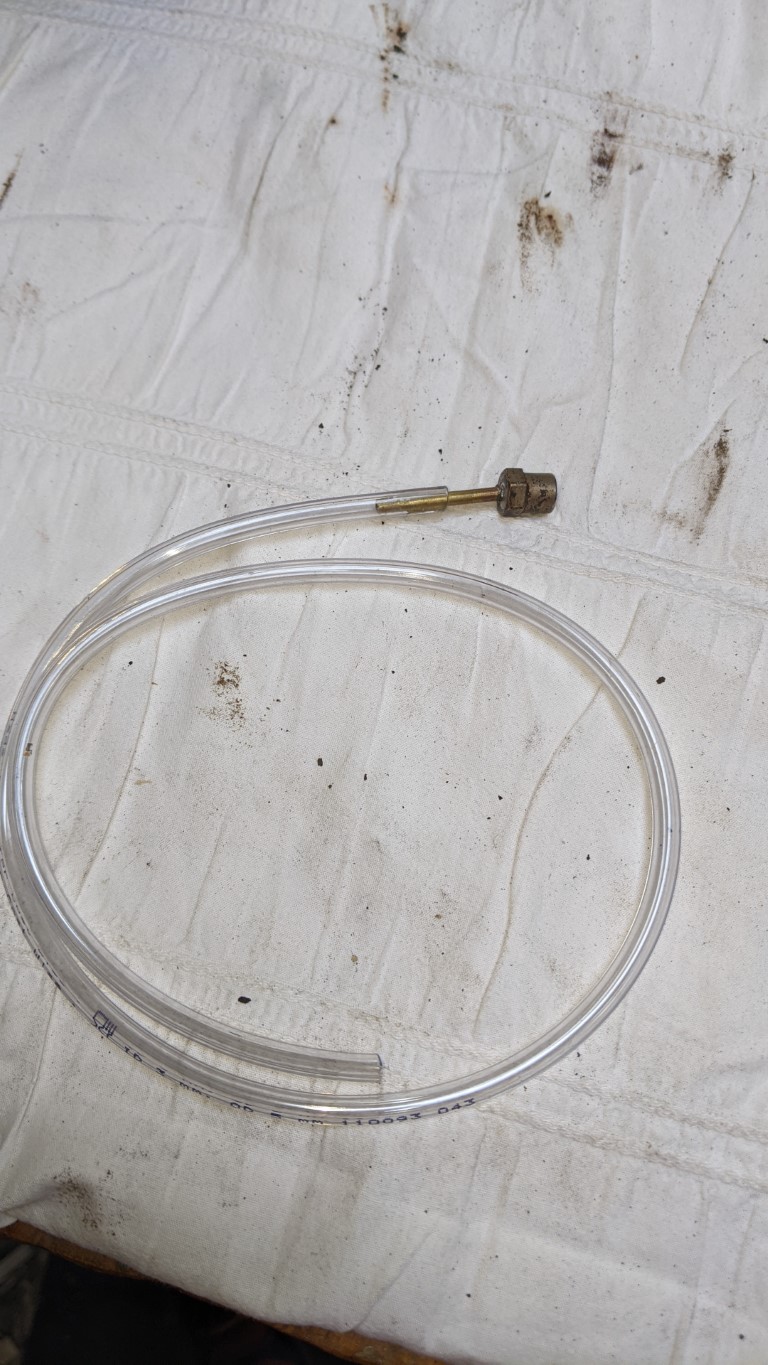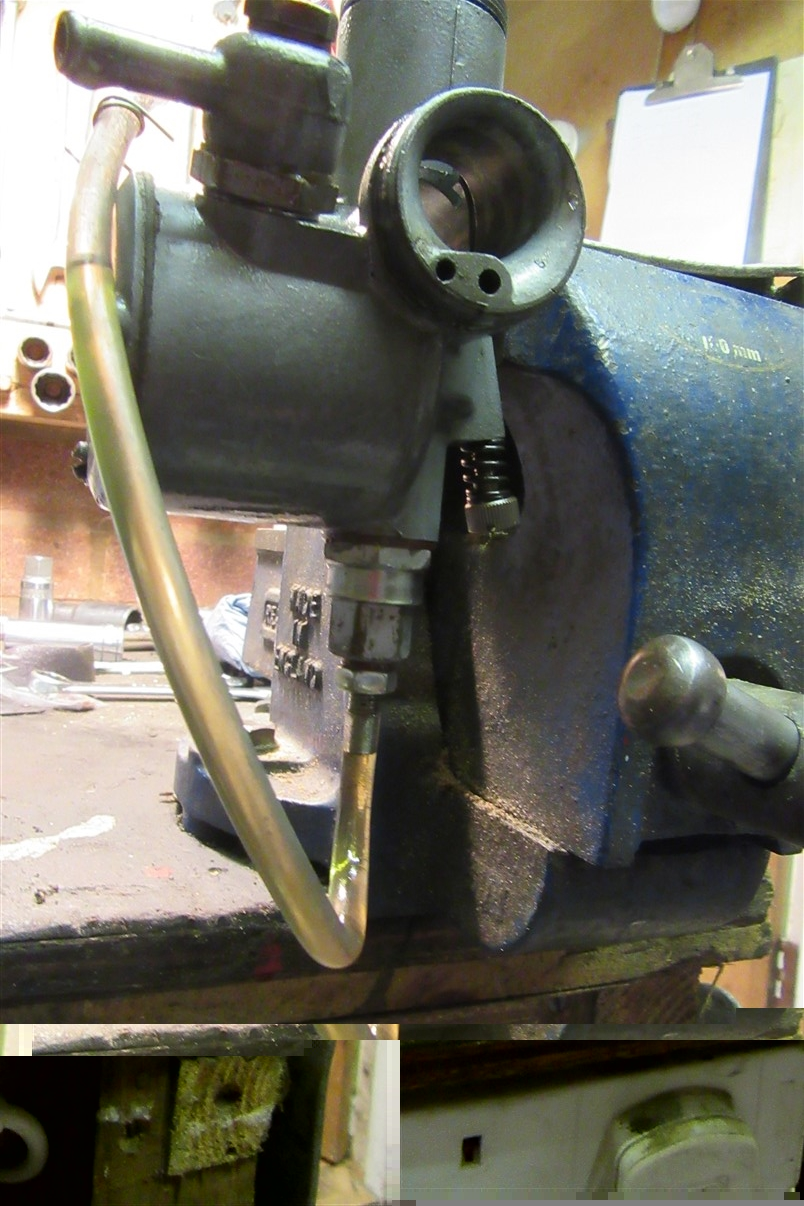How does one check that the fuel level is aligned with the dot on the float bowl cover?
I see that Burlen offer a Float Chamber Cover with 5/16" Push On Connection (part nº 376/142); https://amalcarb.co.uk/monobloc-series/389-series/special-parts/float-chamber-cover-with-pipe.html
Would I be right in supposing that the purpose of this is to attach a length of transparent tube to act as a sight glass? (Discussion elsewhere has discounted this possibility, but so far without suggesting an alternative use.)
Step into your time machine…
- Log in to post comments
On my 650
Admittedly it has twin monoblocks, but I undo the carb - carb connector pipe between the main jet and reposition it up the side of the float chamber to record fuel height.
Just like using non J9 grade fuel hose, you have to be careful with plastics and modern fuel to make sure it doesn't break up/dissolve when they are in contact with each other. I wonder how I know this...
Regards, George
- Log in to post comments
I thought that you could…
I thought that you could undo the pilot jet and push a pipe on there. Or isn't that for Monoblocs? Worth a look.
- Log in to post comments
Think that I was nearly…
Think that I was nearly correct! By sheer coincidence I have just seen a comment on the Velocette OC website saying remove the pilot jet cap and push a pipe on there.
- Log in to post comments
Monobloc Fuel Level
This is what I made many years ago and it works perfectly. I used a spare pilot jet cover and drilled a small hole in it, I then soldered a small piece of brass tubing into it and connected some clear plastic pipe to that. It's a tool for life :)

- Log in to post comments
It is just possible to push…
It is just possible to push a bit of clear pipe onto the pilot jet, it will drip as fuel runs past the thread and its a bit hit miss but it can work. A perspex cover may work if you are quick but is likely to disolve fast. Fuel level also seems to vary a tad with the head of fuel , go with half a tank.
- Log in to post comments
A quick update: discussion…
A quick update: discussion elsewhere suggests that the purpose of the 376/142 cover is to link the float chambers in a twin carb set-up and thus use just one carb to set the level.
And the same discussion supports the idea that one can simply push a length of tube over the bottom of the pilot jet (though an adapted spare cover is preferable).
- Log in to post comments
I took an oversize scrap of…
I took an oversize scrap of perspex, drilled three holes in it and put it on in place of the metal cover. Oversize so the holes didn't break out of the rather brittle material. Make sure the plastic is petrol proof...polystyrene might turn into glue...it wasn't even cut to any special shape.
- Log in to post comments
Hi David , The perspex …
Hi David , The perspex cover you kindly made for me did the job but was disolved by my tank contents in no time ! , perhaps Esso synergy plus has an "ESSO EXTRA bleedooler" component thats not kind to plastics , or the station was passing off cheap E10 as the plus grade . Its been done to me before.
- Log in to post comments
If you are UK based
I can send you an extension with sight glass. To set up your float. But I will want it back… I still have monoblocks on my plunger dommi. Email me
cheers
Jon
- Log in to post comments
The idea of pushing a…
The idea of pushing a plastic pipe over the pilot jet - once the cover has been removed - doesn't work very well, as it not only drips fuel, but also allows thousands of tiny air bubbles to enter the pipe and therefore doesn't give a very accurate reading. I know, because I've tried it many times before and the pipe really must be sealed where it joins the jet and that's why I made an adaptor.
- Log in to post comments
That's all very well, but…
That's all very well, but with the nylon float, how do you adjust the level if its wrong? If I remember correctly (but possibly not) with the old copper floats, you could lightly (!) bend the arm, but can you do this with the nylon float?
- Log in to post comments
Michael, I went back to…
Michael, I went back to using the old type brass float for that very reason. With the plastic float you can raise the level with washers under the float needle union/fitting, but I don't think you can lower it unless you machine a fraction off the top of the carb or from the underneath of the float needle seating union.
- Log in to post comments
Update: did the pipe-on-jet…
Update: did the pipe-on-jet trick this morning and it worked well. It was quite a firm fit, so no real problems of the kind Bob suggests.
The outcome was that the float level is fine.
A further outcome is that the issue I am chasing (richness on tickover) seems to be down to the airway to the pilot jet mixing chamber being partially obstructed.
Twiddling the pilot air screw has no effect on tickover speed — but taking it out completely just about doubled engine speed (no rev counter: judged subjectively) and suppressed the slight but evident black smoke from the silencer.
- Log in to post comments
I have chased richness on…
I have chased richness on pilot settings for some time including having the float needle seating machined. drilling extra air bleeds and increasing bypass sizes. Eventually I concluded that once the engine reached full temperature and the pilot mixture was correctly adjusted then the apparent richness (displayed on reading the plug) would very slowly clear up. I atribute this condition to the poor self cleaning ability of some current spark plugs that absorb carbon into the insulator. Ancient plugs seem to fare better.
- Log in to post comments
Further update: having…
Further update: having dismantled the carb with a view to ultrasonic cleaning, it dawned on me that it is possible to assemble it with the jet block the wrong way round, thus blocking the air passage to the pilot mixing chamber. Did I do this? Impossible to tell now, but when the carb comes back from the cleaners I will at least be on the alert to avoid this error …
- Log in to post comments
I think that the screw in…
I think that the screw in the side of the body engages with the jet block ,so maybe if the block was the wrong way round it would not go in? .
- Log in to post comments





Step into your time machine and travel back to the 70's. Pick up a float bowl extension, and add the perspex cover. I've got one on my Tiger Cub back there.......